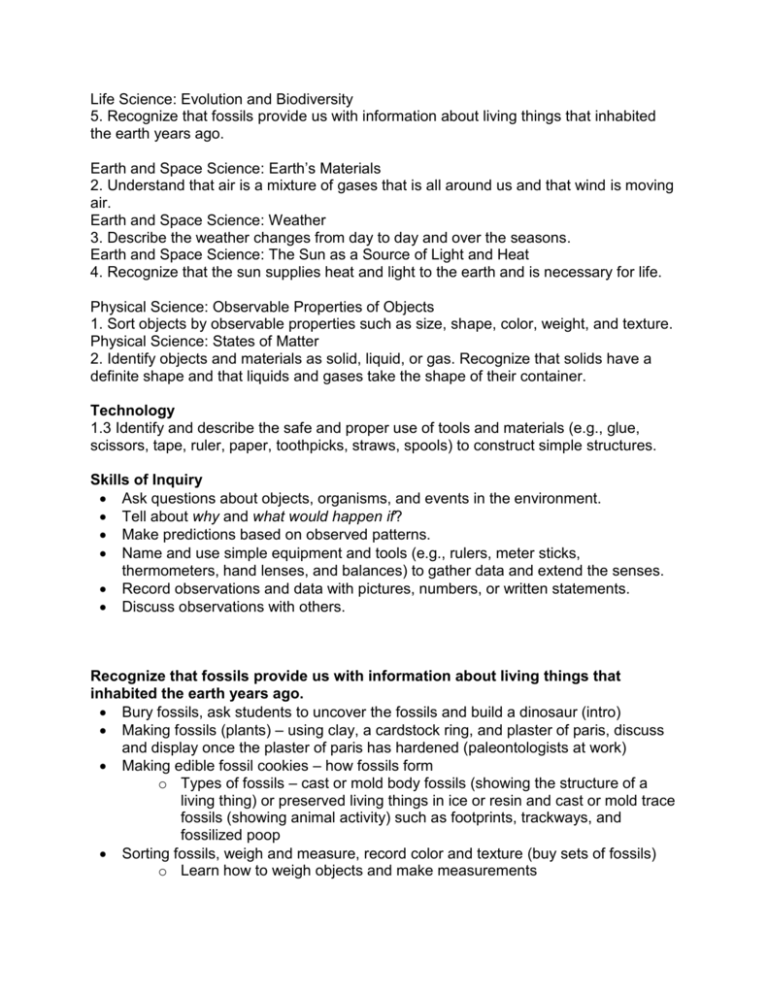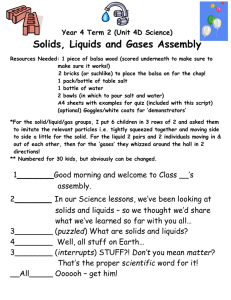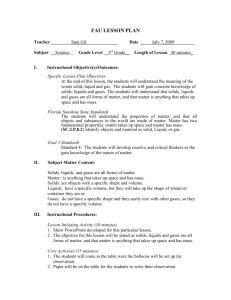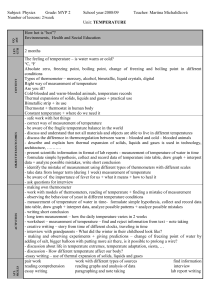1 - Center for Learning in Action
advertisement

Life Science: Evolution and Biodiversity 5. Recognize that fossils provide us with information about living things that inhabited the earth years ago. Earth and Space Science: Earth’s Materials 2. Understand that air is a mixture of gases that is all around us and that wind is moving air. Earth and Space Science: Weather 3. Describe the weather changes from day to day and over the seasons. Earth and Space Science: The Sun as a Source of Light and Heat 4. Recognize that the sun supplies heat and light to the earth and is necessary for life. Physical Science: Observable Properties of Objects 1. Sort objects by observable properties such as size, shape, color, weight, and texture. Physical Science: States of Matter 2. Identify objects and materials as solid, liquid, or gas. Recognize that solids have a definite shape and that liquids and gases take the shape of their container. Technology 1.3 Identify and describe the safe and proper use of tools and materials (e.g., glue, scissors, tape, ruler, paper, toothpicks, straws, spools) to construct simple structures. Skills of Inquiry Ask questions about objects, organisms, and events in the environment. Tell about why and what would happen if? Make predictions based on observed patterns. Name and use simple equipment and tools (e.g., rulers, meter sticks, thermometers, hand lenses, and balances) to gather data and extend the senses. Record observations and data with pictures, numbers, or written statements. Discuss observations with others. Recognize that fossils provide us with information about living things that inhabited the earth years ago. Bury fossils, ask students to uncover the fossils and build a dinosaur (intro) Making fossils (plants) – using clay, a cardstock ring, and plaster of paris, discuss and display once the plaster of paris has hardened (paleontologists at work) Making edible fossil cookies – how fossils form o Types of fossils – cast or mold body fossils (showing the structure of a living thing) or preserved living things in ice or resin and cast or mold trace fossils (showing animal activity) such as footprints, trackways, and fossilized poop Sorting fossils, weigh and measure, record color and texture (buy sets of fossils) o Learn how to weigh objects and make measurements Understand that air is a mixture of gases that is all around us and that wind is moving air. Experiment with bubbles (shape, color, movement), bubbles rise (warm air) and experiment with bubbles blowers of different shapes Use a paper to examine air movement with a fan and make a simple wind vane (something that can indicate wind direction) Make a balloon powered vehicle – design and build (provide students with a wheeled cart, length measurements) Make paper airplanes and experiment with flight (what holds up an airplane?) Recognize that the sun supplies heat and light to the earth and is necessary for life. Learn how to use a thermometer Record outdoor temperatures in a sunny and a shady location – discuss the differences in temperature (discuss differences in light) o Record temperatures on a sunny day and a cloudy day at the same time and locations (discuss differences in light) Plants and sun rainforest unit? Recognize that animals (including humans) and plants are living things that grow, reproduce, and need food, air, and water. Build a terrarium (rainforest) Biodiversity of a circle – different types of plants/animals Recognize that plants and animals have life cycles, and that life cycles vary for different living things. K with butterflies, pandas and 2nd with trout, butterflies, plants life cycle of frogs, chicks (not done in K or 2nd) Recognize changes in appearance that animals and plants go through as the seasons change. Discuss animals that hibernate (garden snail, box turtle, chipmunk, woodchuck, black bear, bat) K with bears Collect food items that a chipmunk stores to eat while hibernating, discuss that they are not found outside in winter, nutritional value Discuss fur changes and winter adaptations of squirrels, woodchucks, mice, raccoon, deer, bats, coyotes Identify objects and materials as solid, liquid, or gas. Recognize that solids have a definite shape and that liquids and gases take the shape of their container. Observe solid, liquid, and gas in plastic baggies, observe different types of solids, liquids and gases (helium balloons) and discuss o Demonstrations that gas takes up space (funnel, can, blow up a balloon with a chemical reaction) o How to measure solids, liquids, and gases (different tools such as graduated cylinder, dropper, balance, scale) Observe water as it changes form (give students ice cubes, allow them to melt, leave cup of water out until it evaporates, discuss what happened to the water) (use a thermometer to help explain how the water changes) – water can be placed in balloons o Use droppers, experiment with leaving cups with different amounts of water and see which cup gets dry first o Boil water and observe the steam, discuss (thermometer) o Call out different examples of water and ask students to identify them as solids, liquid, or gas (using active participation) – examples could be icicles, rain, snow, fog, steam, breath on a cold morning, stream, etc. Molecules and movement with different colors of paper (solid, liquid, and gas) Use a piece of paper, design and make a container that can hold water, how many times can it be filled and emptied before it falls apart, what types of designs work best Sparkle jars – tall glass or plastic jars with lid o Add 2/3 water and 1/3 corn syrup to each jar and use a funnel to add solids such as glitter, sequins, seeds, beads, crayon shavings – observe without shaking and identify solids, liquids, and gases (air bubbles) and then shake and observe Matter Does it take up space? Does it have weight? Is it visible? Solid Yes Liquid Yes Gas Yes Yes Yes Yes Yes Yes No Can it change shape easily? No Yes Yes Name __________________________________________________ Wonderful Water! Solids Record the temperature of ice:_________ Predict what will happen to the ice when we raise the temperature. Liquids Record the temperature of the water: ____________ Predict what will happen to the water when we raise the temperature to boiling. Gas Record the temperature of the water when it is boiling:___________________________ Predict what will happen to the gas when we turn the heat off. Predict what will happen when we put water in the freezer. Draw pictures of the 3 states of matter that water was in our experiments. Materials Needed: Activity #1 paper cup, zip-lock baggie filled with water, two empty zip-lock bags, pencil, a solid object such as a rock or a ball Activity #2 3 balloons for each group: one filled with frozen water, one with water, one with air, one scissors for each group, one empty bowl, chart paper and markers for each group Activity #3 small pieces of paper in three different colors, one for each child in the class Activity #4 vinegar, alka-seltzer or baking soda, one-hole stopper and clear bottle, a second clear bottle, rubber tubing (about 8 inches) or 2 flexible straws taped together. Activity #5 small funnel, 2-liter empty soda bottle filled, un-opened Hawaiian Punch can, punch can opener. Procedure: Activity #1: Hold up a zip-lock bag containing the solid (rock, ball, etc.) Introduce term "solid" Take it out. Ask children to feel it, look at it, etc. Does it take up space? Does it have weight? Does it keep its shape? Ask for other examples of solids, other properties of solids suggested by children; record on chart or board. Hold up baggie with water. Introduce "liquid". Pass around. Does it take up space? Can you see it? Does it have weight? Does it keep its shape? (Pour water into cup so children can see that the liquid takes the shape of its container.) List other liquids, discuss their properties, record on chart or board. Blow air into third, empty baggie. Discuss with children. What's in the baggie? Does it take up space? Does it have weight? (Accept the answer"no".) Does it keep its shape? (Let air out of the bag and ask children where it went.) Discuss other properties, other gases, if any, that children may know the names of. Let them inhale and see how lungs expand like a balloon. Review from board or chart properties of solids, liquids, gases. Activity #2: Pass out to each group the materials for Activity #2. Tell children they are going to investigate the contents of the three balloons and write their observations on chart paper. They will feel the frozen balloon, cut the rubber off with a scissors. Discuss what they see and feel. Do the same with the water balloon, observing the properties of the water both when it is in the balloon and as they pour it into the dish or bowl. Record observations. Feel balloon with air. Let air out. Write observations. Encourage use of descriptive words such as "hard, invisible, wet, splashy," etc. discuss all observations of all groups. Combine onto large chart with the three headings of solid, liquid, gas. Try to accept all observations as valid. Activity #3: Begin by telling the children that all matter is composed of tiny particles called molecules. Pass out colored papers. Have all children with "yellow" come up and demonstrate what the molecules in a solid might look like. (Packed very tightly together; this is why a solid keeps its shape and may feel hard). The next group of children ("blues") come up and demonstrate how the molecules of a liquid act (farther apart' moving, which allows us to pour a liquid). Third group demonstrates molecules of a gas (far apart: moving rapidly) Activity #4: Explain that children will see how another gas, carbon dioxide, takes up space. (Gases are hard for children to deal with since they are invisible; children will need several experiences that demonstrate that air takes up space.) Fill one bottle to the top with water. Put baking soda or alka-seltzer in second bottle; add vinegar, then quickly stop up the bottle with the stopper, which has the hose or straws inserted in it. Place the other end of the hose or straw in the bottle of water and observe the action of the carbon dioxide as it is released in the water. (The reaction lasts for only a short time) Discuss what happened, why, and what we learned about the gas. Activity #5: Show students a funnel. Ask the students what they think will happen to water if they pour it into the funnel. (It will run through and out the spout.) Demonstrate to the students that water does indeed pass through the funnel. Place the spout of the funnel into a flask. Seal the neck of the funnel into the mouth of the flask with clay. Ask the students what they think will happen to water when you pour it into the funnel. (Most will say that it will pour into the flask. When you pour water into the funnel, the water stays in the funnel and does not pour into the flask. The water does not flow into the flask because it is already filled with air. Air is matter and takes up space. Since no air can get out, the space in the flask is filled and no water can get in.) Show them a real life application with the Hawaiian Punch can. Punch one hole in the top of the can. Try to pour liquid out. It should not come out because no air gets in to displace the liquid. Punch a second hole. Now the liquid will pour out because air can get in and push the liquid out.





